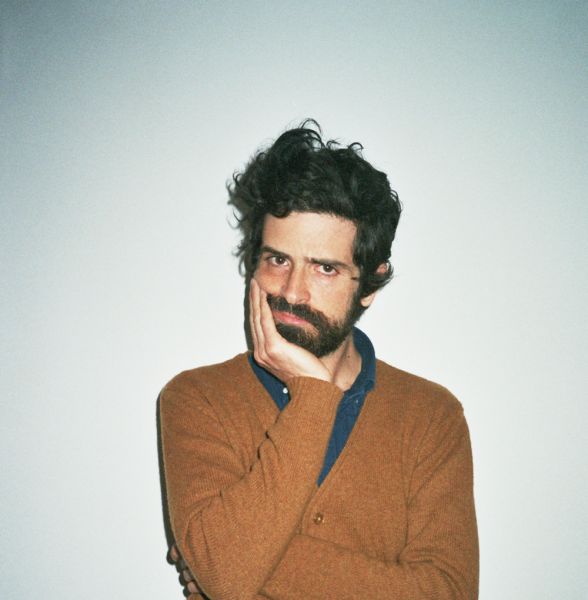I.
The folk goddess Maria Lionza is said to live on top of Montaña Sorte in the Yaracuy region of Venezuela. Artistic depictions, most famously a statue by the sculptor Alejandro Colina overlooking the Francisco Fajardo Highway in Caracas, represent her as well-endowed and powerful woman. Often described as riding a tapir through the jungles of La Gran Sabana holding a female pelvis, she embodies strength and divine femininity—her devotees call her queen. To them, she also comes to represent fertility, peace, nature, music. For generations, Venezuelan musicians and poets have sung her praise, whether they make the trek up Montaña Sorte to dance on coals in her honor or write about her supernatural beauty from Echo Park.
Let’s drink a toast to that strange old feeling
That this is a moment without any meaning
This is a moment without any meaning
II.
Devendra Banhart was born in Houston, Texas to an American father and a Venezuelan mother, moving to Caracas at two years old. Twelve years later, he moved to Los Angeles after his mother remarried. In a 2003 interview with Garrett Kamps—fresh off dropping out of art school, releasing first record The Charles C. Leary independently and spending the summer opening for Sonic Youth in Paris—Banhart will describe his childhood and early teenagehood as one surrounded by “shanties and sweatshops.” He will say Venezuela was “crazy,” and will speak of the very real danger of wearing anything remotely flashy: “You don’t wear nice sneakers because, while here you may get assaulted, there you just get killed.”
I left Venezuela at five years old, only coming back for vacations with a family that, much like Banhart’s, had enough money to stay above the poverty line. I never had the chance to get into trouble in the shanties and sweatshops. Not until twenty-one, finding myself in the very specific context of studying in Argentina, was I able to connect with Venezuelan kids my age that were raised in Caracas. Growing up in Doral, a predominantly Venezuelan suburb of Miami—I never lived around white people before moving to New York City—it never occurred to me that my exposure to Venezuelan culture came in a pre-packaged Americanized form, in gated communities and stealing liquor out of cabinets, in dating girls who listened to The xx and boys who listened to Devendra Banhart.
Let’s make the most of when we stopped believing
Love is the only thing truly worth grieving
Love is the only thing truly worth needing
III.
A gaita zuliana was never missing from my house on Christmas. The sound of a cuatro, blasting out of my father’s old Sony CD player or strummed by my mother around our sofa, became a staple to the point that I didn’t realize until early in my teenage years that not everyone listens to this music on Christmas. I had the lyrics to “La Grey Zuliana” in my head from a young age, the taste of hallacas in my mouth and the stories of pilgrims going to Maracaibo to worship the Virgin of Chiquinquirá—there, lovingly, La Chinita—in my heart, and yet I felt a disconnect. My mother regularly made cachapas. I learned how to make arepas. I speak Spanish perfectly. It is not enough.
This gap in my identity did not register as a prominent part in my life until I heard “Carmensita”, a popular cut from Banhart’s sixth record Smokey Rolls Down Thunder Canyon with an accompanying video where Banhart and then-girlfriend Natalie Portman recreate a Hindu myth to the tune of sparse electric guitar and rolling r’s. Late in high school, armed only with too much knowledge of Vampire Weekend, this was my first exposure to Banhart’s music.
At that point, most of the people I would meet at university had played and replayed his records. Anything under the umbrella of indie music had, at that point in my life, been emotional escapism—I look back fondly, embarrassingly, on listening to Modern Vampires of the City as I sat on a log overlooking the garbage facility by my high school and imagining the Manhattan skyline. Now, suddenly, New York was upon me and I had nothing familiar to grab onto.
I felt a deep kinship in Banhart’s odd mode of carrying himself; this wasn’t a traditional Venezuelan man. I heard this in the way he rolled his tongue on every song, in the way he sang “I Love That Man” on Cripple Crow. He was unphased by machismo, untraditional to the core. I had never heard of any musicians coming out of my country, or with tangential connections, that didn’t draw from traditional music. I found in Banhart a friend who sang in colors I was familiar with and who, despite the sound of a cuatro absent from his music, made me feel connected to the place where I first drew breath, one that even now feels like it’s slipping through my fingers.
IV.
Maria Lionza
Lady hand me real arrows
I don’t know anything about San Francisco save the Golden Gate Bridge, the hazy Summer of Love, and that Devendra Banhart spent his art school days living in The Castro with two gay men and surrounded by the area’s famously vivacious queer nightlife. On “Daniel”, a cut from his eighth record Mala, Banhart imagines heartbreak between men in line at a Suede concert with a sensitivity and tenderness that most heterosexual musicians couldn’t hope to conjure. It surprised me that he was, in fact, straight.
I remember the first time Jason showed me Mala. I remember knowing about Banhart, feeling cool, drinking whiskey and laying on his bed when I should’ve been reading for class. “Daniel” on rotation, slow guitar and light snare played low in dimly lit rooms. Desire for desire overtaking desire for work. Parties. Decent poetry. Betrayals. Shaking hands. Silent, seething pain. Low snare. Low guitar. Headphones. The A Train lights flickering into something reminiscent of low light.
One of the great stereotypes haunting queer men is hyper-sexuality, something scholars and sociologists and anyone on Grindr can attribute to the typical context of being unable to express these desires during actual developmental years. Before I even thought about a men as objects of desire, I was often teased for being soft spoken, and lacking any of the “normal” qualities that make a man “a man”. Eventually, the girls and boys that passed through my bed would muse—begrudgingly or gratefully—that I’m very tender, very feminine for a man.
The first time I saw Banhart play live at Rough Trade in Brooklyn—flailing his hands, singing in high tones, shimmying his hips back and forth between strums of his electric guitar, troublingly skinny—I began to see in a positive light what for so long was a negative. If ever either of us went back to Venezuela, I don’t doubt we’d stick out like sore, displaced, untraditional thumbs. He played “Daniel,” and the crowd swayed as he sang about standing in line, heartbroken, waiting to see Suede play. I held a rose, you held who knows, but that’s fine.
There are people that will forever haunt some records. Mala is haunted for me, but I refuse to let it affect me. Watching Banhart onstage—taking requests, smiling, occasionally talking to the crowd in Spanish—I thought about what a huge waste it would be to let a white man colonize this music for me. Dancing under dim purple light, fighting those old desires for roses and hands and Suede and Irish whiskey, can be an anti-colonial act.
Who do you love
The lover you can’t forget
V.
Today, Venezuela has the highest rate of inflation in the world. The people are starving, the hospitals are mismanaged, and the socialist government—well-intentioned dissidents eager to balance the inequality of wealth in the nation—have put themselves at the top, draining the country’s bountiful natural resources, equalizing a nation through poverty, and wielding the abusive power they proclaimed to be abolishing.
I wish I could begin to explain the helplessness and privilege I felt knowing kids my age were leaving university to protest or abandoning their careers altogether when all I could do is read about it and inform others—mostly white socialists who would attempt to explain my country to me as my extended family leaves in troves. I thought about micro-activism from close friends of mine, sending food and supplies to indeterminate sources. It felt hopeless in the face of the grander scheme of things. I felt selfish to think even the smallest act small.
“Cristobal Risquez,” a standout love song from Mala, is named after Devendra Banhart’s cousin. A doctor working in New York City, he has deep connections within the medical community of Venezuela, and understands well exactly what’s needed for any act of altruism to leave a mark. Three years ago in May, Banhart announced an impromptu show at The Dilettante Annex in Los Angeles as a benefit for Venezuela. Accompanying the ticket link was a personal statement about the proceeds going toward “hopefully just enough to buy a few incubators, antibiotics, and powdered milk.”
The note finishes with hope, Banhart encouraging “donations of any size” and clarifying one thing the general public disconnected from the situation outside of polite small talk and general news updates doesn’t seem to grasp: “even if we merely turn our attentions to Venezuela, if we donate just that, mere attention and contemplation, mere energy, sent with loving intent, it can have an impact.”
Who do you love
I began to really think of the change I could do with what I had available to me, and the fact of the matter is I had so much less than a world-traveled musician with the media contacts and following to be able to make a difference. If the best I could do for now is inform myself, keep others informed, and not lose hope, if I could donate my attention and get others to do the same with loving intent, how could that small drop in the ocean not matter? How could something as seemingly small as a thought or a song not feel monumental?
VI.
It was about three in the afternoon when I arrived at the Retiro Station in Buenos Aires after a weeklong stint in the mountains and forests of the Patagonia. The locals told me that the police won’t bother you for lighting up in the station; cigarette in mouth, I began the search for a kind stranger with a lighter. The first person to catch my eye as I got off the bus toting a traveler’s knapsack was a man not much older than me. He had tired eyes. He was selling milanesa sandwiches, and holding up a sign: recién llegado de Caracas.
He gave me a lighter and I gave him 50 pesos for a sandwich—the conversion in my head amounted to about $2.50 USD. We talked about the state of things back home. He told me about his sister, waiting to come to Argentina in a week. He told me about hitchhiking under cover of night, moving from one tip of the continent to the other.
He asked me how long I had been in Buenos Aires. I looked away, mumbled an excuse, and got in a taxi back to Recoleta, thinking about our separate upbringings, and the very different circumstances that made that encounter possible. I had never felt less Venezuelan.
Early interviews with Banhart focus on his Venezuelanness, an identity thrust on him by biology and birthplace that somehow ties into his music. Reading them and knowing he was born in the States makes this exoticizing all the more uncomfortable. A poignant piece by Romina Puga from the Mala press circuit has him admitting point blank that he “feels Venezuelan everywhere but Venezuela.”
I understood him; it was hard to hear, but I understood. People like Banhart and myself lead an in-between existence—it’s not an uncommon sentiment in first-generation children of immigrants, or in children who are immigrants themselves. There’s a Spanish phrase for this specific kind of displacement: ni de aquí, ni de allá.
Later interviews, finally, focused on the music and not so much on the identity attached to the musician. Even then, Banhart was already branded by the label of “freak-folk,” an eclectic leader that could strum ballads as well as he could write a disco track. Regardless, he made scant appearances in the press, gave scant concerts, and existed as an echo in the mind of fans who keep the fire burning, waiting for something new since the disco-tinged heartbreak of 2016’s Ape in Pink Marble. Made in the wake of several deaths in his personal life, it’s no surprise Banhart opted to lay low and write in peace amidst a world of chaos.
His new record Ma is a soft return to the land of the living and sees Banhart’s most direct confrontation and contemplation of the situation in Venezuela. The video for “Abre Las Manos” features shots of Caracas, still-lifes that evoke a peace and beauty I’ve lived and can evoke through the haze of memory. More than any song of support or calls to action, Banhart invites us very simply to look, knowing most are scared at even attempting to visualize what’s happening, conjuring hard images with his signature genteel in a way that negates one the opportunity to turn away:
Mira el abasto cubrido de sangre
Te estaba buscando pero no hay nadie
Mira el museo fue destrozado
Por gente que nunca habia entrado
Mira la fila, veinte mil horas
Ahí está mi tía esperando su pan
Qué porcentaje de gente con hambre
Es necesario pa’ que algo cambie
Ayer mi vecina fue secuestrada
Quería contarte pero eso no es nada
Seeing Banhart perform live in Argentina was an augmented version of the Rough Trade show I had seen a few years back—he spoke to the crowd exclusively in Spanish, made jokes about Argentine rock legends Sumo, danced with a confidence and exuberance that had made me feel the same way. A month into my four months in another country, I once again found myself bound by “Carmensita.” A friend of mine had a similar experience seeing him in Paris during a book signing where he wrote the Spanish word for “share” in her notebook and gave her a hug and comfort amidst the tumult of the first month away.
When she returned to Miami, I went with her to get comparte tattooed on her wrist.
Or the lover you haven’t met
Who do you love
South of the equator, December is the hottest month. On one particular late night, the summer’s humidity creeping into the heart of Buenos Aires, I was walking back to spend the night with someone I had just begun to trust. We walked into a convenience store to get ice cream when I heard the music blaring low from the speakers inside switch into a very familiar mode: the strumming of a cuatro, the slow shake of maracas, the joyous voices of my childhood—I couldn’t pinpoint the gaita, but I remember squeezing Jose’s hand a little harder at the mention of La Chinita. It’s these little spurts of emotion that remind me where I was born, where I haven’t been able to return since I was fifteen, where I still feel so attached even though I will never be able to acclimate should I someday return. It’s hearing a gaita in an Argentine convenience store. It’s speaking Spanish with the guy selling arepas out of a food truck on Astor.
Kevin O’Donnell interviewed Banhart for Vulture about seventh album What Will We Be, focusing the most interesting parts of the conversation on the crisis in Venezuela. Banhart spoke of the country’s instability from afar, unhappy with Hugo Chavez and his nationalist politics when in the country and understanding the way he’s idealized by socialists when he’s outside Venezuela: “Any music on the radio has to have some modicum of an indigenous instrument. I find that to be a totally fucking fascist way of instilling some sort of culture… but I guess he’s trying to remind people that Venezuelan culture is extremely valuable.” Cooper goes on to ask about “Maria Lionza,” deeming the song a “spacey, multipart opus.” Banhart defines the song as an invocation: “In the beginning, I state my woes to the goddess…we state her name and ask her for something. When it comes to her reply, it’s ineffable, so that part is instrumental.”
And yet for me it goes back to the lyrics. I remember listening to it for the first time and being surprised there was no Spanish in a song about an indigenous goddess. I was met instead with a floaty prayer for arrows amidst floaty, breathy vocals and proclamations of love that grow into a flurry of acoustic guitar, light drums, light piano, light.
I still think about meeting him after the Rough Trade show, stumbling into an awkward hug, giving him a Venezuelan candy, and overall making an absolute fool of myself. He smiled at me, hugged me back, and called me pana. I tried to meet Banhart again after his show in Buenos Aires, but the throng of Argentine fans both blocked me and turned off the shy musician from doing anything other than jumping in a car and onto the dark roads of Palermo Soho. I can find solace in his music and in evocations to goddesses I may never meet, knowing that there’s one mortal who understands, to some extent, the most complicated thing I’ve neglected to put into words until now.
The lover you can’t forget
Who do you love
Or the lover you haven’t met
Who do you love










